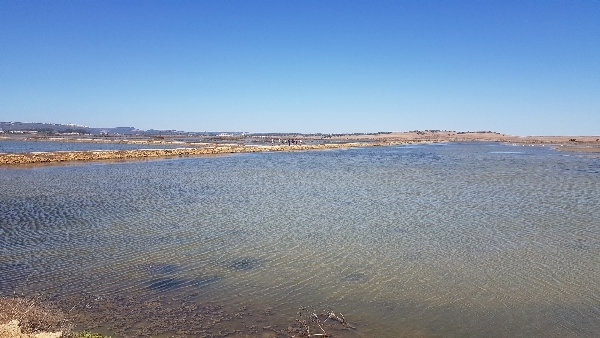
LA JANDA – MONTENMEDIO GOLF COMPLEX – RIO BARBATE ESTUARY – BARBATE MARSHES
WEATHER: bright sunshine for most of the day, a nice breeze. Temp 24 – 27C
La Janda is always a joy to visit, so many birds can be seen, it is such a great area with many habitats contained within it. Today was no exception we spent two or three hours having a great time and we saw a great variety of species.
We arrived at 8:15 after a short drive from the hotel, we stopped on the approach track to scan the recently ploughed fields on either side of us. We intended to look for Calandra Larks but got distracted by the high number of Kestrels on the wires and pylons. We counted a total of 40 Kestrels and they were all Lesser Kestrels and despite the light being against us we had good scope views of them.

A typical track at La Janda
A large flock of Sparrows landed in a far bush, scoping them revealed that they were Spanish Sparrows and whilst watching them we discovered our second Roller of the trip! Considering I have never seen a Roller on this migration trip before, two is off the scale. Looking further afield we picked out another good sighting in the shape of Black-winged Kite, now this one was really distant but easily recongnisable.
Looking down over the bowl-shape valley of La Janda we could see dozens, if not hundreds of White Storks. Cattle Egrets cross-crossed the sky, as did flocks of Sparrows, Corn Bunting and Jackdaws. We drove down to the central track that bisects the whole of La Janda and gave us superb views of both sides of the central 'drain' or canal.
A Ferruginous Duck flew along the main drain that lies adjacent to the central track, we saw lots of Zitting Cisticolas, two or three Turtle Doves, Stonechats and more Spanish Sparrows. A little further along the track we put a Purple Heron and then we found a single juvenile Night Heron in the reeds. A Green Sandpiper went onto the list as did Red-legged Partridge, Little Egret, Grey Heron and two Marsh Harriers.

five of the group at La Janda
We got fairly close to the Black-winged Kite before it flew off, Paul got a few pictures of it. The Ferruginous Duck reappeared flying in the opposite direction and we added Moorhen and Common Kestrel to the tally at a bridge.
The track that eventually leads you to Benalup was in good condition, so we drove along it making a couple of stops before the ‘smelly farm’. The first stop produced more Turtle Doves, a Cetti’s Warbler sighting and a distant Black Kite.
Near the ‘smelly farm’ we searched for roosting Red-necked Nightjars, the usual habitat had been removed, the trees were gone, so we searched in different areas and eventually found two and had glimpses of a third. During this time we added Common Buzzard, Common Pheasant and saw more Turtle Doves to our sightings.
We drove off La Janda along the west track, making a few stops to look at Woodchat Shrikes, Griffon Vultures and Bee-eaters. We stopped to let another car pass coming the other way, they put up a Wryneck that was sitting on the side of the track, only two of us saw it! After waiting a while for the Wryneck to return we moved on without seeing it again.
From La Janda we drove towards Vejer de la Frontera and along the way we pulled into Montenmedio Golf Complex to look for the Bald Ibis. This reintroduced species has favoured the golf complex during the post breeding period, who knows why I can’t say? However, none were there during our visit, we did find Spotted Flycatcher, Little Owl, Willow Warbler and a few Stonechats.

Barbate Marshes Natural Park
We made a brief stop at the base of the Vejer escarpment to look at the breeding site of the Bald Ibis before driving onto the town of Barbate. After collecting lunch supplies from a supermarket we drove to the estuary of the Rio Barbate.
It was great birding on the marshes at Barbate Estuary on a falling tide. Hundreds of birds were out there, we added; Mediterranean Gull, Eurasian Curlew, Oystercatcher, Osprey and Grey Plover to our growing list. Other interesting species listed were: Audouin’s Gull, Greater Flamingo, Redshank, Greenshank, Whimbrel, Dunlin, Sanderling, Ring Plover and Black-winged Stilt.

there are hree Bald Ibis and a Cattle Egret with the cows in this compound
On the Natural park we parked up for lunch but nor before stopping to watch and photograph a dozen or so of Bald Ibis. They were feeding in the small cattle pens adjacent to main road, I have seen them there many times before.

a proper picture of the Bald Ibis, An ugly bird but very photogenic, taken by Paul Barry
The vast area of flooded gravel pits and tracks of Barbate Natural Park was alive with birds, we bumped into another birding group led by Chris Mills and he told us of a Collared Pratincole sighting. So after lunch we walked a short way and found the bird.

all necks and legs - a bunch of Greater Flamingos
Dozens of Audouin’s Gulls sat in the distance and found more waders including Avocets and a single Turnstone. Driving further around the perimeter track we saw Woodchat Shrike, Crested Lark, Stonechat, Goldfinches and Linnets. Our next stop was next to a series of islands in the main lagoon, there we found a couple of Eurasian Spoonbills and 10 Stone Curlews, another target bird in the bag.

Eurasian Spoonbills
Scanning the marshes again, we found more Spoonbills, lots of Avocets, Greater Flamingos and two more Ospreys! Just then a large flock of larks took to the air behind us, they were Calandra Larks, I estimated that there were over 100 of them. Walking along the track to try to get a better view of the larks (which we didn’t) we found two juvenile Montagu’s Harriers, doing what harriers do!

record shot of two of the ten Stone Curlews seen at Barbate
One final scan of the lagoons produced our last new species of the day when a small group of Black-tailed Godwits dropped onto a muddy bank in the middle of the water.
Well, that was a very satisfying day, we were very pleased with our sightings and we got back to the hotel at a sensible hour.
We added another 20 species to our tally of 135.
